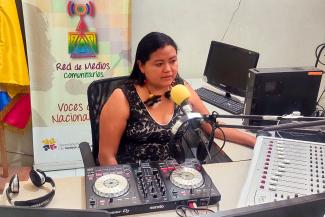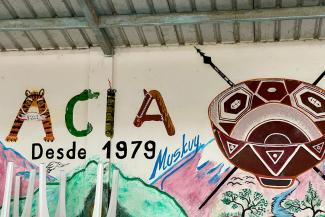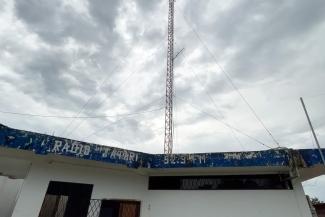Transmitting knowledge
How Radio Jatari connects Indigenous communities in Ecuador
Gilberto Olmedo is a member of the Shuar Indigenous group who lives in the Arajuno community in Pastaza, one of three provinces where Radio Jatari Kichwa 92.3 FM helps listeners in the Ecuadorian Amazon stay connected. It’s aptly named — in Kichwa, Radio Jatari translates to “The Radio that Unites the Community.”

Gilberto Olmedo, a Radio Jatari listener.
Fundación Esquel
In Ecuador, Indigenous people face various economic, political, and cultural threats, including loss of their languages and cultural practices, while their land in the Amazon is threatened by illegal logging, mining, and land conversion, as well as large-scale infrastructure projects, such as oil and gas, road construction, and dams.

Radio Jatari Kichwa listener and local community member Judith Huatatoa stands outside the station.
Noelia Gutiérrez, USAID
Radio programming in Spanish, as well as in the Kichwa and Shuar languages, is broadcast several times per day, enabling listeners like Gilberto to listen to music in Shuar, hear perspectives of the significance of Indigenous culture and nationality, and learn about various topics — from the protection of ancestral lands from a human rights and gender justice perspective to the harvesting of guayusa, a plant that is medicinally and economically important in daily life.
“For me, as a radio listener, the most important thing is the issue of education,” Gilberto explained.
The provinces of Pastaza, Napo, and Orellana are isolated areas in the Amazon region, largely composed of Indigenous populations. Because these rural territories are so large and communities are spread out, it’s difficult for local populations to access information regarding what goes on in the region and beyond.
Although these remote communities experience a lack of access to technologies such as cell phones and internet networks, radios are a fixture of everyday life. In some cases, community radio is the only source of information for remote communities.

Members of the Association of Indigenous Communities of Arajuno (ACIA) outside of the organization’s headquarters.
Fundación Esquel
Gilberto’s son, also an avid listener of Radio Jatari, is a member of the Association of Indigenous Communities of Arajuno (ACIA). ACIA created Radio Jatari to reduce the communication gaps between more than 200 Kichwa populations. For decades, ACIA has fought to preserve and conserve Indigenous Kichwa communities’ ancestral lands, traditions, and identities.
The Amazon region’s remote Indigenous groups face significant challenges when advocating for their interests, namely lack of political and social inclusion; limited access to resources, services, and technology; and reduced organizational capacity. USAID supports organizations like ACIA by helping them to build capacity to advocate for economic and political policies that serve the Kichwa people’s best interests.
Through USAID’s Strengthening the Capacity of Indigenous Organizations project under the Amazon Regional Environment Program, ACIA participated in a one-year training process to strengthen its administrative and financial management capacities. USAID and ACIA shared the goal of ensuring Indigenous people actively participate in the development of their communities.

The Association of Indigenous Communities of Arajuno (ACIA)’s Director of Communication Sandro Culcay tests out USAID-provided equipment in the Radio Jatari Kichwa station.
Noelia Gutierrez, USAID
ACIA identified communication as an area where it wanted to grow so that the organization could better exercise and demand their collective rights. In response, USAID provided radio broadcasting equipment to ACIA so that it could expand the service coverage area of Radio Jatari Kichwa to the three provinces, reaching about 40,000 listeners living in remote villages of the Amazon.
ACIA’s Director of Communication Sandro Culcay says the radio is for “transmitting knowledge from the elders who have great wisdom to the youth who need to bond with each other and know the history.”
Thanks to radio programming on social, cultural, and environmental issues, Kichwa communities can now keep up with news in Ecuador and from around the world. Indeed, through “The Radio that Unites the Community,” the community stays together.
To learn more about how USAID partners with Indigenous people and promotes inclusive and sustainable development in the Latin America and Caribbean region, visit: AREP and All in LAC



ABOUT THIS STORY
To reduce threats to the Amazon’s forests, waters, and peoples, USAID’s Amazon Regional Environment Program (AREP) implements activities across Brazil, Colombia, Ecuador, Guyana, Peru, and Suriname to complement bilateral work in these countries.
The Amazon region’s 1.6 million indigenous people are important partners in biodiversity conservation but face significant challenges when advocating for their interests to outside economic and political interests. Through the Strengthening the Capacity of Indigenous Organizations in the Amazon, USAID supports indigenous peoples’ organizations to strengthen their institutions in order to defend their rights.
ABOUT THE AUTHORS
Kayden McKenzie is a Development Outreach and Communications Specialist at USAID/Ecuador.
Noelia Gutierrez is a Development Outreach and Communications Specialist and Project Management Specialist at USAID/Peru.
Chelsea Milko McAllister is a Senior Communications Advisor in USAID’s Bureau for Latin America and the Caribbean.

